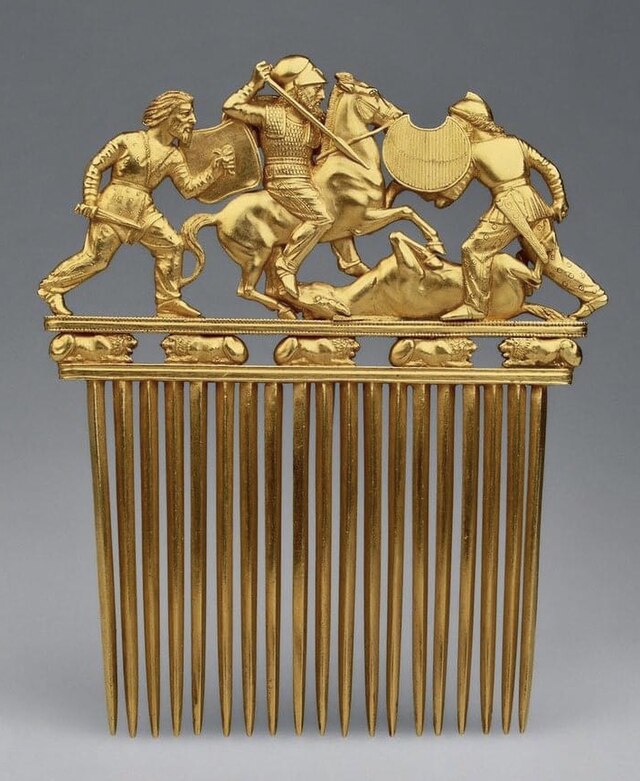斯基泰人
历史上的民族 来自维基百科,自由的百科全书
斯基泰人(古希臘語:Σκύθης/羅馬化:Skūttēs,或Σκύθοι/羅馬化:Skūttoi,複數:Σκύθαι/羅馬化:Skūttai;英語: Scythia/Scythian,複數:Scythae/Scythians)也譯為斯基提亞人 、西古提人[1]、叔提雅人[2]、西徐亞人或塞西亞人,為古代在東歐大草原至中亞一帶居住與活動、操東伊朗語支的游牧民族或半游牧民族,他們的領土被稱為斯基提亞;古代波斯人稱之為塞克人(古波斯語:Sakā,也譯為薩迦人),共分為戴尖帽塞克人、飲豪麻汁塞克人、海邊塞克人[3]。中國《史記》、《漢書》記錄的塞種可能源自這個民族[4]。



主流學術界普遍認同斯基泰人為伊朗人的分支[5],其語言屬東伊朗語支[6],並信仰一種前祆教時期古伊朗宗教[7]。為最早使用騎兵的民族之一[8],在西元前8世紀取代了辛梅里亞人成為東歐大草原的霸主[9],在這段時期斯基泰人及其分支民族幾乎統治了整個歐亞大草原,從喀爾巴阡山脈一直到陝甘寧盆地都是他們的勢力範圍[10][11],創造了人類歷史上首個游牧帝國[9][12]。盤據在今烏克蘭和南俄一帶的斯基泰人自稱「蘇格洛提」(Skoloti),由稱為「斯基泰皇室」的游牧戰士貴族所帶領。
在西元前7世紀,斯基泰人與西米里亞人一起跨越高加索山脈並頻密地洗劫中東地區,為當地的政治發展充當了重要角色[9][12]。大約在西元前650到630年,斯基泰人短暫支配了位於伊朗高原西部的米底王國[13][14],並將其勢力範圍擴展至埃及邊境[8]。而在失去米底王國的控制權後,斯基泰人仍持續介入中東的地區事務,並在西元前612年的尼尼微戰役中扮演領導角色,摧毀了亞述帝國,隨後與波斯帝國頻密發生衝突。西元前4世紀,斯基泰人先被馬其頓王國重挫[8],隨後逐漸被另一支伊朗民族薩爾馬提亞人征服[15]。西元前2世紀後期,他們位於克里米亞半島的首都拿波羅利斯被本都王國的米特里達梯六世佔領,而他們剩餘的地盤亦被合併到博斯普魯斯王國[7],並大幅度被希臘化。在西元3世紀,斯基泰人和薩爾馬提亞人一同被另一支伊朗民族奄蔡人統治,並一直被哥德人侵擾。中世紀早期,大量的斯基泰人和薩爾馬提亞人被同化和吸收到早期斯拉夫民族中[16][17]。
斯基泰人在絲綢之路中扮演重要角色,促進了希臘、波斯、印度和中國文明的商業繁榮[18]。在城市定居的金屬工匠為斯基泰人所打造的飾品別具風格,後世稱之為斯基泰風藝術[19]。
名稱
語言學家Oswald Szemerényi研究過各種可能是Scythian的同義詞後梳理出以下幾個字: 「Skuthes」(Σκύθης)、「Skudra」、「Sug(u)da」和「Saka」。[20]
- 「Skuthes」(Σκύθης)、「Skudra」、「Sug(u)da」派生自印歐語字根「(s)kewd-」意思是「推進、射擊」(與英語的shoot同源)。「*skud-」是同一個字元音變換後的產物。Szemerényi還原了斯基泰人的自稱為「*skuda」(大致上是「射手」的意思,也與英語的shooter同源)。這派生出古希臘語「Skuthēs」Σκύθης(複數形式:「Skuthai」 Σκύθαι)以及阿卡德語「Aškuz」。古亞美尼亞語: սկիւթ「skiwtʰ」是基於愛歐塔化的希臘語而生。後來斯基泰語中的輔音由/d/變成/l/,由「*skuda」變成「*skula」,成為了後來希臘語詞彙「Skolotoi」 (Σκώλοτοι)的字源,也就是希羅多德所提到斯基泰皇室成員的自稱,其他的聲音改變還產生了「Sogdia」也就是粟特。[21]
- 「Saka」一字則源於古波斯語:「Sakā」,古希臘語:Σάκαι、拉丁語: 「Sacae」、梵語:शक「Śaka」皆源自伊朗語的「sak-」,「前進、遨遊」也就是「游牧」的意思。儘管關係密切,但薩迦人(Saka)還是和生活在歐洲的斯基泰人有分別,他們主要生活在歐亞大草原的北方和東方以及塔里木盆地。[22][23][24]
在學術界,斯基泰人一詞一般指涉在西元前7世紀到西元3世紀間活動在東歐大草原的的伊朗游牧民族[25]。
斯基泰人與幾個生活在他們東方的民族都共享了相似的文化包括武器、馬俱和藝術,被稱為「斯基泰三角」。[26][27]共享相同特徵的文化常被稱為「斯基泰文化」,而這些民族也被稱為「斯基泰人」。[28][29]與斯基泰文化有聯繫的民族不止斯基泰人自己,還包括一些截然不同的民族[30],諸如辛梅里安人、馬薩革泰人、薩迦人、薩爾馬提亞人和各式各樣的森林草原民族,[26][28]諸如早期斯拉夫人、波羅的人和芬蘭-烏戈爾人。[31][32]在這廣義的「斯基泰人」下,一般都會以「古典斯基泰人」、「西斯基泰人」、「歐洲斯基泰人」或「旁狄斯基泰人」作區別。[28]
斯基泰學學家Askold Ivantchik沮喪地指出,「斯基泰人」一詞廣義和狹義混著來用會造成巨大的混亂。因此他對以「斯基泰人」一詞來指西元前7世紀到西元3世紀間統治東歐大草原的伊朗民族有所保留。[26] 狄宇宙寫道,「廣義的斯基泰的定義根本廣到不行」,認為以「早期游牧民族」代替更為可取。[27]
語言
斯基泰語屬於印歐語系東伊朗語支[33],但是否所有物質文化受他們影響的族群都說同樣的語言目前尚未確定。而與古斯基泰語最接近的是奧塞提亞語[34]。
薩爾馬提亞語、于闐語和薩迦語都有可能斯基泰語所產生的方言連續體[35]。
在中世紀早期,斯基泰語因為大量的斯基泰人及其分支族群在隨著斯拉夫大遷徙和突厥大遷徙時被征服和同化而被取代,但大量的詞彙則因此而流入斯拉夫諸語和突厥諸語中。目前唯一存活的是西部分支的奧塞提亞語[36]。
外表
根據目前考古所得的藝術品所見,斯基泰人是明顯的西歐亞人[37]。而根據歐亞各地區的古文明在西元前5到西元4世紀的歷史文獻記載,斯基泰人都是白皮膚、紅或金髮、藍或綠眼的[37][38][37][39][37][37][40]。
基因
2017年,兩份分別發表在《自然-通訊》和《科學報告》期刊的報告指出,斯基泰人的母系血統與東歐的塞那亞文化相同,但同時亦吸收了東歐亞人的母系血統[41][28]。
Krzewińska et al. (2018)發現,塞那亞文化的男性成員身上的Y染色體屬於單倍群R1a1a1(R1a-M417),而這個單倍群在青銅時代擴張到幾乎整個歐亞大陸。相比之下,6具目前在東歐發現的古典斯基泰人(或稱為「真斯基泰人」)的男性古屍卻屬於常見於西歐人的R1b1a1a2(R1b-M269)並與阿凡納謝沃文化、安德羅諾沃文化有緊密關係。作者認為,斯基泰人並非塞那亞文化的直接後代,但他們都源自於顏那亞文化。而斯基泰人與其他物質文化相似的遠東族群在基因上有著巨大差異,因此可以判斷他們是獨立的族群,只是在物質文化上可能有著共同的源頭,其傳播位置大約在東歐大草原東部到烏拉爾山脈南麓[42]。
2019年,一份研究物質文化與斯基泰人相似的南西伯利亞歐迪貝爾文化的古屍的報告發表在《人類遺傳學》期刊,指出歐迪貝爾文化的男性Y染色體屬於單倍群R1a,其中有兩個是R1a1a1b2(R1a-Z93),並檢驗到有混合東亞人基因,報告結果表示,斯基泰人與歐迪貝爾文化的族群在父系血統上完全不同[43]。
參見
附註或參考
參考文獻
延伸閱讀
外部連結
Wikiwand - on
Seamless Wikipedia browsing. On steroids.

